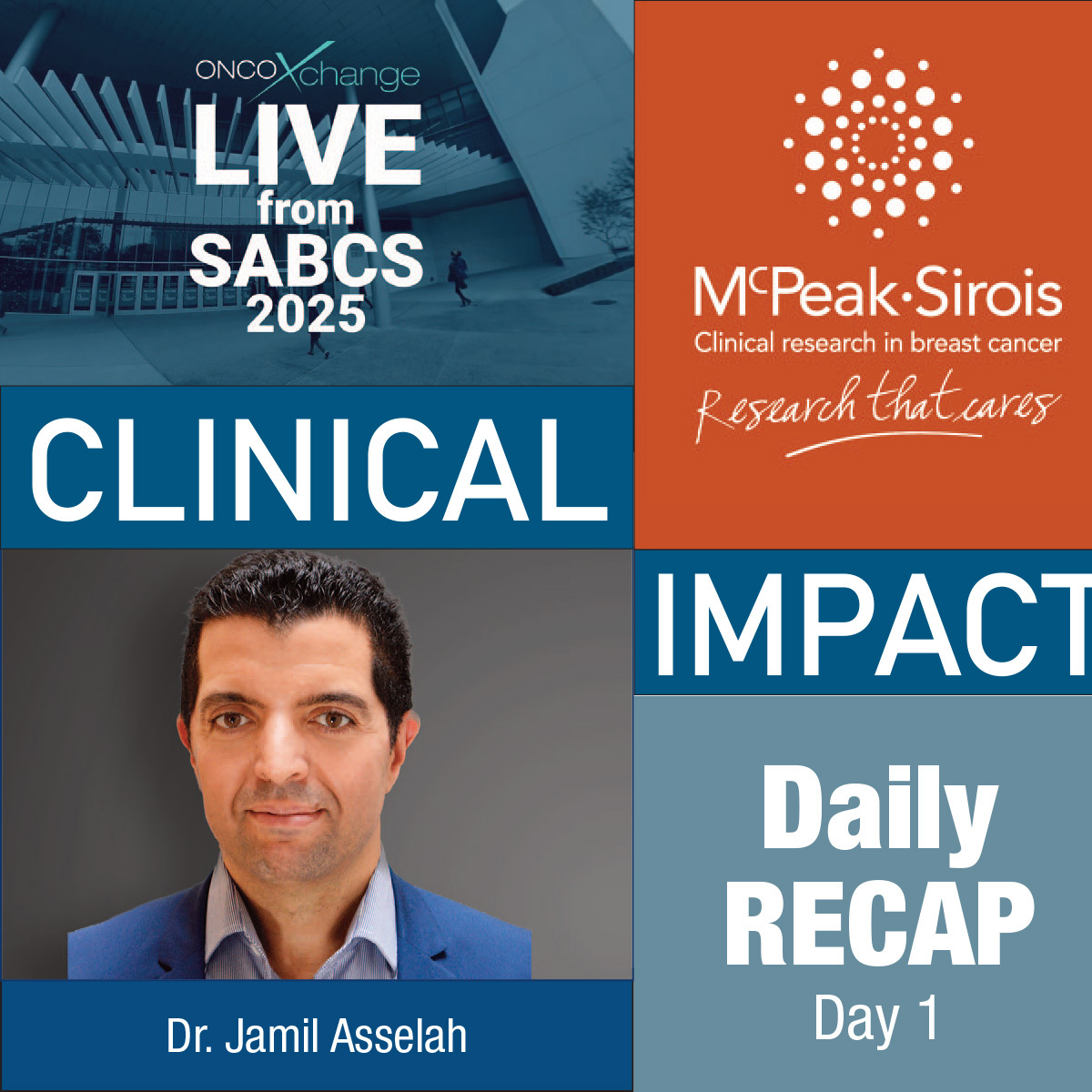
ASCO 2022 - Utility of genomics in HR-positive, HER2-negative breast cancer focus of clinical science symposium
June 2022
By Wayne Kuznar for oncoXchange
The theme of the Dr. Bernard Fisher Memorial Annual Clinical Science Symposium at the 2022 ASCO Annual Meeting was the utility of genomics to guide treatments in patients with hormone receptor (HR)–positive, HER2-negative breast cancer. Here are some highlights from the symposium.
ESR1 F404 mutations and acquired resistance to fulvestrant
New findings from plasmaMATCH identify ESR1 F404 mutations as a novel mechanism for resistance to fulvestrant in patients with pre-existing activating ESR1 mutations. There were presented by Belinda Kingston, MD, from the Breast Cancer Now Toby Robins Research Centre, Institute of Cancer Research, London England.
Little is known regarding resistance mechanisms to fulvestrant. plasmaMATCH was a phase 2b study that used ctDNA testing to identify actionable mutations that made patients eligible for entry to treatment cohorts with matched targeted therapies. Cohort A, the focus of Dr. Kingston’s presentation, enrolled 84 patients with advanced breast cancer with ESR1 mutations in their baseline ctDNA; all patients were being treated with escalated-dose fulvestrant. Patients had a median of 3 prior lines of therapy for advanced breast cancer.
ctDNA sequencing was performed at baseline for all patients and at end of treatment for 68 patients. The most frequent mutations were D538G and Y537S and 49.4% had more than 1 ESR1 mutation.
“Just over 50% (n=35) of patients acquired pathogenic mutations by the end of treatment timepoint,” she said. Seventeen (25%) acquired potentially targetable alterations, including PTEN, BRCA1/2, PIK3CA, HER2, and BRAF mutations. Six patients (9% acquired ESR1 L536 mutations and 3 (4%) acquired ESR1 F404 mutations, which have not been described previously amongst ESR1 mutations, she said.
There were 7 ESR1 F404 mutations acquired in the 3 patients, and of patients with a progression-free survival (PFS) ≥16 weeks, 12% acquired F404 mutations.
“We found that F404 mutations are rare in the absence of prior fulvestrant exposure,” she said, noting that other datasets have found F404 mutations in patients with prior fulvestrant exposure at a rate of 1.5% to 6.0%.
ESR1 F404 was found to occur in cis with activating mutations. Of 7 assessable F404/E380Q double mutations, 6 occurred in cis. ESR1 F404 likely contributes to fulvestrant binding, she said, and induce fulvestrant mutations.
In cohort A, baseline ESR1 mutations potentially associate with PFS—Y537C have longer and Y537S have a shorter median PFS on fulvestrant.
Treatment with an alternate selective estrogen receptor down regulator, or tamoxifen, may overcome resistance that develops to fulvestrant in this patient population, said Dr. Kingston.
Allelic dosage of RB1 and CDK4/6 inhibitor treatment resistance
Allele-specific copy number analysis shows that loss of heterozygosity (LOH) and allelic imbalance of RB1 are associated with shorter PFS in patients with metastatic breast cancer treated with CDK4/6 inhibition, reported Anton Safonov, MD, from Memorial Sloan Kettering Cancer Center, New York City.
His group sought to define the effects of pretreatment RB1 allelic copy number status on outcomes of patients treated with CDK4/6 inhibition plus endocrine therapy, and the likelihood of developing RB1 loss-of-function (LOF) mutations on such treatment through the analysis of an expanded cohort of patients with metastatic estrogen receptor-positive breast cancer.
A total of 322 patients who underwent genomic sequencing prior to their first CDK 4/6 inhibitor on the MSK-IMPACT trial were included. Of these, 99 (30.7%) exhibited RB1 LOH, 39 (14.0%), 118 (36.6%) exhibited diploid RB1 state, and 105 (21.6%) had other patterns of RB1 allelic imbalance.
All nondiploid RB1 states were associated with significantly shortened PFS relative to diploid, but only het loss remained significant when adjusted for fraction genome altered (FGA; HR = 1.66, P =0.0044). “Poorer outcomes initially seen in the other allelic imbalance groups may have been driven by FGA while the poorer outcomes with RB1 het loss were independent of this phenomenon,” he said.
The shorter PFS conferred by LOH and other allelic imbalances of RB1 may occur as a result of acquired RB1 LOF mutations under selective pressure of CDK4/6 inhibitor, concluded, Dr. Safonov. “RB1 het loss may be predictive of PFS on CDK4/6 inhibitor plus endocrine therapy, and predictive of acquisition of RB1 LOF variant as a resistance mechanism,” he said.
Real-world data and the utility of cf DNA in identifying resistance to early treatment in advanced breast cancer
Clinical genomic analysis of real-world cell-free circulating tumor DNA (cfDNA) is feasible. Seth Andrew Wander, MD, PhD, from Massachusetts General Hospital Cancer Center, Boston, presented data from the INFORM clinical genomic database to characterize the resistance landscape of both CDK4/6 inhibitors and PI3K inhibitors
INFORM is an aggregated commercial payer claims database from >200,000 patients with cfDNA results. For this analysis, Dr. Wander and colleagues identified >23,000 breast cancer patients in the INFORM database, more than 6,700 of whom received CDK4/6 inhibitors and nearly 800 of whom received a PI3K inhibitor (alpelisib).
RB1 and ESR1 alterations were found to be significantly more frequent post-CDK4/6 inhibitor therapy (P<0.001 for both), with no difference in PIK3CA alterations.
PIK3CA became significantly less frequent while PTEN alterations became more frequent, but not significantly so, after PIK3K inhibition. A higher proportion of PIK3CA alterations were sub clonal after alpelisib treatment (from 16% pre-alpelasib to 25% post-alpelasib), he said.
He concluded that using cfDNA, specific ESR1, RB1 and PTEN alterations that appear likely to occur under the pressure of CDK4/6 inhibitor therapy were identified. This real-world analysis examining RB1 LOF alterations adds further evidence to suggest that it may be both a primary and acquired resistance mechanism to CDK4/6 inhibition.
ctDNA and serum thymidine kinase 1 activity matched dynamics
Data on biomarkers predictive of response to ribociclib plus endocrine therapy in HR-positive, HER2-negative breast cancer patients are limited and inconclusive. New data suggest that baseline and dynamic patterns of ctDNA and thymidine kinase 1 (TKa) can predict response to ribociclib and letrozole, according to Grazia Arpino, MD, from the Department of Medical Clinics and Surgery, Università Federico II, Italy.
BioltaLEE is a phase 3 single-arm multicenter trial that enrolled 287 patients with HR-positive, HER2-negative advanced breast cancer who were naïve to systemic anticancer therapy and received ribociclib plus letrozole as first-line treatment. Liquid biopsies were collected at baseline and various time points to identify novel biomarkers and their association with clinical outcome. At baseline, ctDNA analysis was carried out using 533-amplicon Custom AmpliSeq HD panel with amplicons covering the coding exons of 39 breast cancer-related genes.
TKa is a cytosolic enzyme with a role in DNA synthesis and cell proliferation. Previously, an absence of target-detectable mutations and a low level of TKa at baseline were shown to be associated with good prognosis in patients receiving ribociclib and letrozole. Also, clearance of target-detectable mutations or TKa sustained suppression after 15 days of therapy were associated with lower risk of progression.
The aim of the analysis presented here was to assess the prognostic and predictive value of combined analysis of both ctDNA and TKa at baseline and day 15 of the first cycle of therapy. Median follow-up was 26.9 months. Early dynamics were assessed for both biomarkers in 241 of the 287 patients.
Wild-type and TKa-negative patients had the best PFS while those with mutations and high TKa levels had the worst PFS. On multivariate analysis, baseline ctDNA and TKa were independently informative.
ctDNA and TKa dynamic patterns were independently informative. Wild-type and a TKa-negative pattern were associated with the best PFS and mutational tumor burden and a positive TKa pattern with the worst PFS. Both ctDNA and TKa patterns were independently predictive of PFS in a multivariate model.
These findings suggest that combining the early dynamic assessment of both ctDNA and TKa may improve outcome prediction in patients treated with ribociclib and letrozole.

Comments (0)